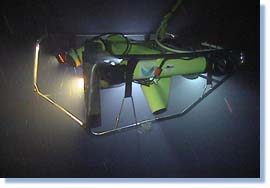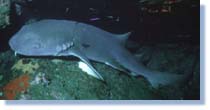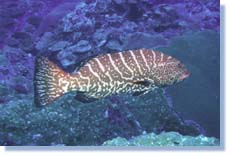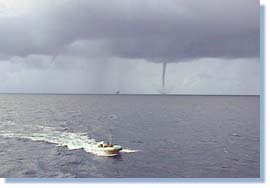|
from the Flower Garden Banks National Marine Sanctuary Sustainable Seas Expeditions, click here.
|
||||||||||
|
Error processing SSI file On August 29, DeepWorker pilots Steve Gittings, Edie Widder, Peter Vize, and Emma Hickerson departed Key West on board the NOAA Ship Ferrel and steamed towards the Flower Garden Banks National Marine Sanctuary. Flat, calm seas and dolphin and whale spottings brought hopes for good weather during the missions. Unfortunately, the sea state took a downward turn about the time the Flower Garden Banks hit the radar screen. Although faced with unpredictably bad weather, and certain logistical problems, a total of 12 DeepWorker dives were conducted in the short time nature cooperated. Coral Spawning A
remotely operated vehicle is deployed to
document spawning. Weather and sea
conditions did not permit scuba or
DeepWorker dives to be conducted during
this event. (Photo credit:
FGBNMS) Unfavorable sea states disrupted submersible diving operations for the remainder of the first week, so scuba and ROV operations were continued. Spawn collections were made using scuba. Samples from blushing star coral, Stephanocoenia sp., verified that this species' eggs are fertilized prior to release from the female coral. Geological Exploration Emma
Hickerson, research coordinator for the
sanctuary, prepares for a dive. (Photo
credit: Frank Burek) On the east bank, Jim Gardner and Dave Lott used technology provided by the U.S. Geological Survey to navigate the ROV to points of interest in and around the brine seep. The ROV was also used to explore the north ridge of a graben area. The U.S. Geological Survey mapped the Flower Gardens in the winter of 1998 using high resolution multibeam sonars. The images were taken originally to test equipment but were spectacular and informative, stimulating further interest. A paper on this work was published in the recent dedicated issue of the journal Gulf of Mexico Science (for copies, email emma.hickerson@noaa.gov). Fish Censuses The
nurse shark (G. cirratum) was one
of several shark species seen during the
Expeditions. (Photo credit: Frank
and Joyce Burek) Next Laddie and Emma headed west over the sand, which was filled with yellow-headed jawfish (Opistognathus aurifrons) dancing over their holes. As they descended, the terrain changed to rubbly chunks of drowned reef. Several very large circular piles of rubble revealed large sand tile fish (Malacanthus plumieri) busily picking up chunks of the rubble and moving the rubble to the perimeter of their territory. With continued descent, the rubble turned to algal nodules, hiding all sorts of cryptic species. Emma hopes to return to this zone next year to collect some of these nodules to assess the contents -- likely micromolluscs, sponges, etc. The deepest depth reached by Emma and Laddie was about 260' (87m) where there were large outcroppings. A roughtongue bass (Holanthias martinicensis) was seen among the outcroppings. Tiger
grouper, Mycteroperca tigris, and
several other grouper species were seen
around piles of reef rumble, perhaps
preferred habitat. (Photo credit: Frank
and Joyce Burek) One limitation of the DeepWorker, discovered during REEF roving diver surveys, is that it cannot get close enough to the substrate to allow the pilot to see the cryptic species. Georeferencing One of the major accomplishments of the missions at the Flower Garden Banks was the use of the tracking system. This system allowed pilots and topside technicians to georeference notable observations, such as the cleaning station with the cottonwicks, an anchor, a cable, or a particularly large congregation of grouper, so that in future expeditions pilots and scientists will know where they have been and what to look for. This
water spout was only one of the weather
hazards that plagued the Expeditions
during its first week at the Flower Garden
Banks National Marine Sanctuary. (Photo
credit: FGBNMS)
|
||||||||||





